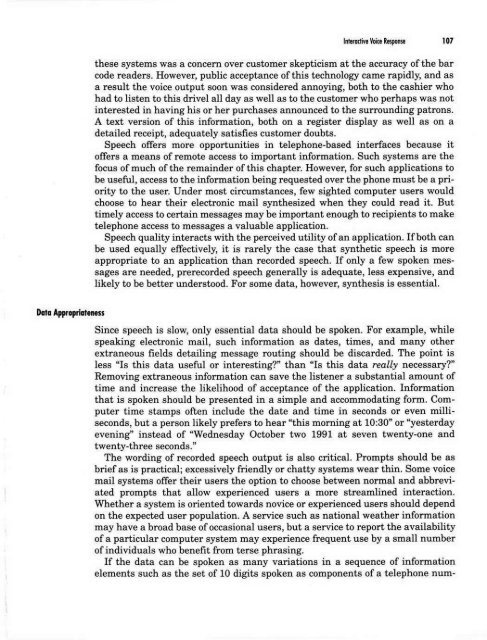MAS.632 Conversational Computer Systems - MIT OpenCourseWare
MAS.632 Conversational Computer Systems - MIT OpenCourseWare
MAS.632 Conversational Computer Systems - MIT OpenCourseWare
You also want an ePaper? Increase the reach of your titles
YUMPU automatically turns print PDFs into web optimized ePapers that Google loves.
Own Apprpdlness<br />
Inktrodive Va Re<br />
these systems was a concern over customer skepticism at the accuracy of the bar<br />
code readers. However, public acceptance of this technology came rapidly, and as<br />
a result the voice output soon was considered annoying, both to the cashier who<br />
had to listen to this drivel all day as well as to the customer who perhaps was not<br />
interested in having his or her purchases announced to the surrounding patrons.<br />
A text version of this information, both on a register display as well as on a<br />
detailed receipt, adequately satisfies customer doubts.<br />
Speech offers more opportunities in telephone-based interfaces because it<br />
offers a means of remote access to important information. Such systems are the<br />
focus of much of the remainder of this chapter. However, for such applications to<br />
be useful, access to the information being requested over the phone must be a priority<br />
to the user. Under most circumstances, few sighted computer users would<br />
choose to hear their electronic mail synthesized when they could read it. But<br />
timely access to certain messages may be important enough to recipients to make<br />
telephone access to messages a valuable application.<br />
Speech quality interacts with the perceived utility ofan application. If both can<br />
be used equally effectively, it is rarely the case that synthetic speech is more<br />
appropriate to an application than recorded speech. If only a few spoken messages<br />
are needed, prerecorded speech generally is adequate, less expensive, and<br />
likely to be better understood. For some data, however, synthesis is essential.<br />
Since speech is slow, only essential data should be spoken. For example, while<br />
speaking electronic mail, such information as dates, times, and many other<br />
extraneous fields detailing message routing should be discarded. The point is<br />
less "Is this data useful or interesting?" than "Is this data really necessary?"<br />
Removing extraneous information can save the listener a substantial amount of<br />
time and increase the likelihood of acceptance of the application. Information<br />
that is spoken should be presented in a simple and accommodating form. <strong>Computer</strong><br />
time stamps often include the date and time in seconds or even milliseconds,<br />
but a person likely prefers to hear "this morning at 10:30" or "yesterday<br />
evening" instead of "Wednesday October two 1991 at seven twenty-one and<br />
twenty-three seconds."<br />
The wording of recorded speech output is also critical. Prompts should be as<br />
brief as is practical; excessively friendly or chatty systems wear thin. Some voice<br />
mail systems offer their users the option to choose between normal and abbreviated<br />
prompts that allow experienced users a more streamlined interaction.<br />
Whether a system is oriented towards novice or experienced users should depend<br />
on the expected user population. A service such as national weather information<br />
may have a broad base of occasional users, but a service to report the availability<br />
of a particular computer system may experience frequent use by a small number<br />
of individuals who benefit from terse phrasing.<br />
If the data can be spoken as many variations in a sequence of information<br />
elements such as the set of 10 digits spoken as components of a telephone num<br />
107

















